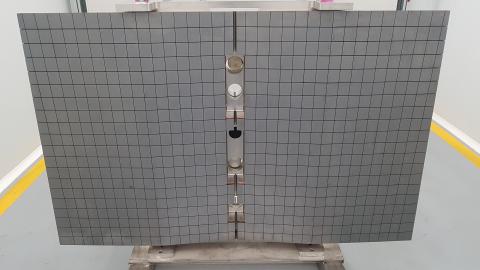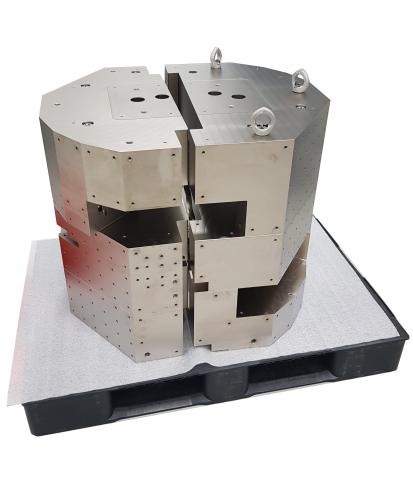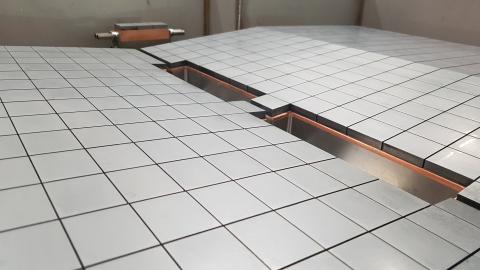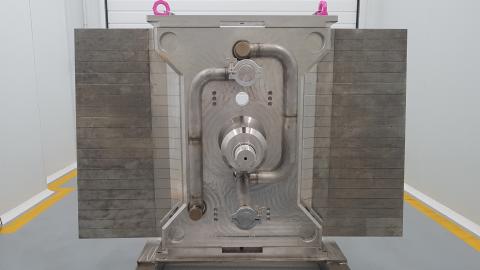LEADING METAL MECHANIC SOLUTIONS, S.L.
Imagen

1
Imagen

2
Imagen

3
Imagen

4
Pic legend 1: F4E-OPE-443-03 FSP FWP Front (LEADING)
Pic legend 2: TS1 Project Beryllium Reflector (LEADING)
Pic legend 3: F4E-OPE-443-03 FSP FWP Detail (LEADING)
Pic legend 4: F4E-OPE-443-03 FSP FWP Back (LEADING)
General information
-
Company nameLEADING METAL MECHANIC SOLUTIONS, S.L.
-
AddressBarrio La Agüera, s/n - 39409 - San Felices de Buelna, Cantabria (Spain)
-
Turnover24.36 million EUR in year 2023
-
Employees158 in year 2023
-
SMEYES
-
Contact Info:
-
Phone+34942814052
-
Emailgestion@leading.es
Activity and Skills
LEADING is a horizontal mechanical and mechatronic solutions company with 50 years of experience in strategic sectors from engineering to advanced manufacturing techniques, such as precision machining, mechano-welding, complex unions (laser, orbital, HIP, brazing, beryllium, coatings, thermal treatments, assembly of mechatronics, NDT and DT examination among other services.
FUSION CAPACITIES: Mechanical Engineering: mechanical design (2D/3D) and engineering simulations, Components manufacturing (prototype/series) and integration of turn-key systems., Beryllium workshop, one of the most advanced in the world. Beryllium is one of the science-preferred materials for its high-performance applications.
Contracts for Big Science facilities
[CERN]
Supply of Machined Pure Beryllium Samples
(2024)
Supply of 1 long and 12 short beryllium samples for qualification welding of new Ultra-High vacuum beryllium chambers. The contract includes Procurement of the raw material; Machining of the Beryllium Samples; Cleaning after machining of the Beryllium Samples; Inspection & Testing; Packing and Shipping to CERN site.
[JET- Imperial College of London
]
Manufacturing of AlBeMet Acoustic Resonators for JET (Joint European Torus) fusion reactor – Ref. CE/4681220
(2023 - 2023)
[F4E]
Series Manufacturing of the FW panels – Ref. F4E-OPE-0900-03
(2020)
Supply of the Normal Heat Flux (NHF) First Wall (FW) panels that represent the in-kind European contribution to the construction of the ITER blanket.
The subject matter of the Contract is divided into 2 parts:
Firm Part:
Covers 3 tasks, already awarded and in development:
Task 1: Implementation of Industrial Organization
All the activities needed to build an industrial organization (“Production Line”) for the Series Manufacturing of the First Wall Panels.
Task 2: Process Qualification
All the activities needed to Qualify the Industrial Organization (“Production Line”) built during the Task 1 manufacturing three identical FWP, called Pre-Series Panels (PSP).
2.3 Tasks 3.2: Series Manufacturing
Manufacturing of the awarded Batches of NHF FW panels (an initial Batch of 27 units) using the built and qualified Industrial Organization (“Production Line”).
The Reopening of Competition Part covers the supply of up to 161 panels grouped into Batches.
Project on going (since January 2021)
[ESS BILBAO]
Design of manufacturing plan and manufacturing of Proton Beam Window (PBW) – Ref. 035/20
(2020 - 2024)
The PBW-System set is about 4,000 mm high, 1,000 mm in maximum diameter and 15 tons in weight, and consists of a set of elements located in the lower zone (PBW and Auxiliary Systems) that perform the main functions; and two other sets in the upper region: a system of Refrigeration and Vacuum Piping (3) that feeds the system integrated by PBW and Auxiliary Systems (1), and a set of shielding blocks (2) that fill the necessary volume to protect the entire system from radiation.
The set formed by (1) + (3) is known as PBW-Plug.
The set formed by PBW-Plug + (2) is known as PBW-System.
The main tasks developed were the following: manufacturing design, manufacturing, testing packaging and transportation to the ESS facilities in Lund (Sweden).
[NRG (Nuclear Research and consultancy Group)
]
Beryllium Reflector Elements for the HFR Petten – Ref. 2020-271
(2020 - 2021)
Fabrication, inspection and delivery of twelve new beryllium filler elements and four new beryllium corner plugs, beryllium reflector elements used as replacements in the reactor core, as part of the HighFlux Reactor (HFR) preventive maintenance program.
[F4E]
Provision of Industrialisation studies for First Wall Series Productions – Ref. F4E-OPE-1041
(2020 - 2020)
Industrialization Studies in the frame of the ITER First Wall Panels (FWP) Series Manufacturing. The procurement of the 215 Normal Heat Flux (NHF) First Wall (FW) panels are carried out by F4E through other contracts.
The purpose of this contract was to carry out an industrialization study and cost assessment of the FWP series based on manufacturing sequence and experience gained in the frame of a full-scale prototype.
Task 1: Industrialization Study: analysis of the input information from reports and experiences from the prototype manufacturing; development of investments (facilities, machines, buildings, etc.) needed for FWP series manufacturing; development of Cost Estimation including activities related to engineering, design, qualification and commissioning of the facilities.
Task 2: Cost Assessment: Cost estimation for both manufacturing of the FWP Series and the investments needed for the manufacturing.
[F4E]
Manufacturing of Welded Support Mock-Ups – Ref. F4E-OPE-1060
(2019 - 2020)
The scope included the manufacturing or six clamshells per drawing and two pieces of pipe of 48,3m outside diameter x 2.77mm thickness, 600mm long.
[ITER ORGANIZATION]
Tokamak Assembly Contract no.2 (TAC-2) – Ref. I0/19/CT/4300001900
(2019 - 2024)
The IO awarded two Contracts at the same time, TAC-1 and TAC-2, to cover the main Tokamak Assembly Works for Phase 1; the scope of these Contracts was predominately mechanical assembly and installation.
The IO defined the assembly process through Construction Work Packages (CWPs). Each CWP defined a package of work to be performed as a unit by the contractors, with a defined start and completion point and a required schedule. The full work scope of TAC-2 involved several hundred CWPs.
Within each CWP the typical work of the contractor consisted of: Development of Installation Work Packages (IWPs) from the CWP; Preparation and issue of detailed as-built drawings; Review of the work steps and identification; custom machining of IO supplied components; development and documentation of installation tests and verifications…
[STFC
]
TS1 Project Beryllium Reflector – Ref. UK SBS PR17134
(2018 - 2019)
Supply of a modular solid beryllium reflector assembly for Target Station 1 of ISIS Neutron and Muon Source. The supply concerned the finished beryllium components as well as a materials test specimen of minimum dimensions: 100 x 50 x 20 mm. The basis of the reflector design was a series of machined blocks of solid beryllium, with an approximate dimension of 700 x 700 x 780 mm. after final assembly. The overall assembly is made up of 13 modular blocks. These modular blocks form two halves that can be separated to allow access for maintenance, to the components located inside.
The base material was manufactured using ground powder consolidated by and Hot Isostatic Pressing (HIP). The scheme of the ordered beryllium blocks from original HIP has been agreed between manufacturer and purchaser -8 Beryllium raw material blocks manufactured by Materion (S-200-FH)-.
Proper Quality, Manufacturing, Safe Handling, Coating, Cleaning and Packaging ad hoc procedures were developed for this project.
[ESS BILBAO]
Manufacturing of Distributor Assembly – Ref. 296/18
(2018 - 2019)
Assembly, welding, and final machining of Distributor Set.
Main tasks developed:
• Assembly
• Welding
• Water cutting
• Marking and identification
• Cleaning
• Visual examination
• Liquid penetrant examination
The material used for all structural parts was AISI 316L SS with forging, rolling or tube process as requested in the drawings
NDT were performed in all welding and VT and PT in all accessible areas.
Welding of the tubes on both sides were performed with orbital TIG and all other welding with manual TIG.
Depending on the geometry, dimensions and shape roughness achieved was between 0.8-1.6.
Cleaning of the piece according to standard process for stainless steel in LEADING Clean Room.
[F4E]
Manufacturing of Prototypes of the Supports of the Blanket Cooling Manifold (BCM) System and Application of Coatings on Different Items – Ref. F4E-OPE-0833
(2018 - 2019)
Manufacturing of a Prototype of Support of the Blanket Cooling Manifold System and Application of Coating on Pieces of Pipe. The scope concerned the manufacture and supply of prototypes of pipe supports of the Blanket Cooling Manifold (BCM) system. The scope of supply also included the coating with alumina of pieces of pipes to be assembled with the support.
An End of Manufacturing Report including all the relevant information (procedures, drawings, test reports etc.) was delivered at the end of the manufacturing and testing activities.
Recommendations for the series production were made, and budgetary cost estimates were prepared for the series production through a Cost Estimation Task: Cost estimation for the manufacturing of the Blanket Cooling Manifold (BCM) System with different support design alternatives. Two support configurations were assessed: with diffusion bonded joints (Hot Radial Pressing) or bolted.
[ITER ORGANIZATION - AMW (Ansaldo Nucleare & S.p.A, Mangiarotti S.p.A)
]
Sub-assemblies for ITER Vacuum Vessel
(2017 - 2018)
Supply of parts and/or sub-assemblies for ITER Vacuum Vessel (VV) project for the fabrication of the poloidal segments. The scope of LEADING was focused on high precision machining of parts. The highest challenge was to obtain a segment within the requested tight tolerances, considering that this is a first-of-a-kind component.
Extra-long tools (special spindles) were needed for the fulfilment of machining operations. Complex machining strategies were carried out step by step: pre-roughing roughing, pre-finishing and finishing machining. Programming operators were attached to the project during all the manufacturing process to control the machining strategies referred above. Engineering-to-manufacturing tasks were developed to fulfil the requirements (the 3D models provided were not suitable for machining). Marking, Testing (VT -Visual Test- and PT -Liquid Penetrant Test-) and polishing of all parts. All parts were measured in a 3D CMM.
[F4E]
Splice Plate Custom Machining for JT-60SA TF-Magnet – Ref. F4E-OPE-0805
(2017 - 2018)
This contract covered the following work on the splice plates for the assembly of the JT-60SA TF Magnet Outer Intercoil Structure: collection of the 316LN SS blank splice plates from their manufacturer; Rapid ‘just-in-time’ custom machining of each of the splice plates individually according to measurements supplied by F4E from the installed positions of the TF coils, including the preparation of the necessary drawings and machining instructions; Qualification of a suitable sandblasting process and its rapid application to the surfaces of the splice plates after machining; Rapid delivery of each set of customized splice plates individually to the QST Fusion Research Site in Naka, Japan.
The contract excluded the measurement of the installed coil positions and the installation of the splice plates, which were included in the contract between Toshiba and QST.
The supply consisted of 190 units (18 sets of 10 splice plates).
[ESS BILBAO]
Fabrication of ESS Target Cassettes – Ref. 162/16 and ESS Cassette Bricks Patterns Ref. 310/16 and 312/16
(2016 - 2018)
The tasks developed consisted of manufacturing of two prototypes, 36 serial units and 1 spare unit of the cassettes that shall contain the tungsten blocks in the target wheel, also including the development of the different productive processes associated to the manufacture of the prototypes (machining, assembly, sealing welding, NDE).
Tasks developed:
• Preproduction stage phase, material purchasing (bricks and raw material for cassettes manufacturing) and all manufacturing, cleaning and testing process were qualified and approved according to RCC-MRx and ESS particular conditions and specifications.
• Proper technical instructions were developed specifically for the project when needed (dimensional control, chemical cleaning).
• Control of 100% of individual parts before and after assembly (general external dimensions and flatness control).
• Assembly and Load Test.
[F4E]
Supply of Full-Scale Prototypes of the ITER Normal Heat Flux (NHF) First Wall (FW) Panels – Ref. F4E-OPE-443-03 (IV-PT)
(2014 - 2020)
The project concerned the supply of a prototype for Normal Heat Flux (NHF) of a panel for the first protective wall of ITER (FWP), Scale 1:1 (FSP: full-scale prototype); and the development of related technology.
The FSP refer to the modules of row 12 of ITER.
The FSP consisted of a bi-metallic support structure made of CuCrZr bonded to a 316 L (N) SS plate –called heat sink- on which Beryllium tiles (armour) are joined. Joining of these materials have been done by HIPing for both the joint between support structure and CuCrZr and the joint between Beryllium and CuCrZr.
The FSP represented a full original FW panel of the NHF design. It included the connections for the inlet and outlet cooling water (pipes), the 4 radial pads, the 4 X-pads and the bolt system inside the barrel (central cylindrical extension).
[F4E]
Fabrication of a Standard Semi-Prototype of the ITER Normal Heat Flux (NHF) First Wall (FW) Panels – Ref. F4E-OPE-394 (IV-PT)
(2012 - 2016)
The project concerned the supply of one First wall (FW) semi-prototype as well as the related technology developments as required for the manufacture.
The work was subdivided into 3 tasks: task 1 delivered small-scale mock-ups representing the standardised Normal Heat Flux (D-NHF) FW design, task 2 delivered 1 semi-prototype for the same standardised FW design and task 3 delivered of a mock-up containing a Cu foil for joining Be tiles. The semi-prototype represented 6 complete fingers of the final FW panel and have Beryllium tiles joined onto the CuCrZr heat sink layer by Hot Isostatic Pressing (HIPping). The mock-up of task 3 also contained Beryllium tiles.
The final report described, for each task, the entire manufacturing process used to fabricate the semi-prototype and the final choices on the technologies for the ITER FW panel fabrication.
Relevant R&D projects
[CDTI - TRANSMISIONES]
Development of advanced manufacturing technologies to produce large-scale components to enhance the competitiveness of Spanish industrial sector in Fusion
(RODAS (MIG-20242038)
)
(2025)
The main objective is to address the challenges associated with producing large, complex, and high-performance components that are crucial for the successful operation of fusion reactors.
The project has defined different activities that will organize in a coordinated way the research for the development of design and simulation tools, raw materials specifically designed for fusion applications, advanced manufacturing processes for metals compatible with large components, equipment for manufacturing and characterization that allow to advance in the manufacturing of complex components in an efficient, sustainable and scalable way.
The RODAS project is articulated around 3 fundamental pillars: Materials, Advanced Manufacturing and Advanced Testing. These innovations are expected to contribute to the advancement of fusion energy research in Spain and globally.
[CDTI - MISIONES]
Advanced manufacturing for the development of critical technologies for the construction of DEMO and the advancement of the fusion roadmap, based on challenges identified during the design and construction of ITER
(ROAD2DEMO (MIP-20221013)
)
(2022 - 2024)
ROAD2DEMO shall address activities that enable research into the development of key enabling processes, materials and technologies, promoting disruptive breakthroughs. Specifically, the main objective of ROAD2DEMO focuses on advancing research in critical and fundamental technologies that will enable significant breakthroughs in nuclear fusion:
- The use of critical materials and handling of high value-added components is especially important in this type of facility.
- Sustainable and advanced manufacturing processes such as Additive Manufacturing (AF), thin film coatings and low temperature joining represent a breakthrough approach to the manufacture of functional components, promoting substantial savings in critical materials and operating costs.
- The detection and identification for early warning of harmful emissions, ensuring safe and reliable handling of materials, and the subsequent manufacture and processing of components made of Be and/or its alloys.
[CDTI - MISIONES]
Industrial technological research focused on the optimization of the efficiency of IFMIF-DONES large scientific fusion facility
(DONES-FLUX (MIP-20221017)
)
(2022 - 2025)
DONES-FLUX shall approach with a global vision an optimisation of the different flows within IFMIF-DONES, which will allow for a state-of-the-art intelligent installation that can eliminate inefficiencies that put its operation and maintenance at risk, especially in the current scenario of energy crisis. Specifically:
- An intelligent system with buffering capacity and intelligent demand management will be developed to control the flow of energy in the grid.
- Developments will be carried out to optimise particle beam flow control (extraction systems, radio frequency cavities and AI strategies).
- Lithium flow will be controlled, using non-contact measurement systems that allow real-time monitoring of both flow characteristics and intelligently supported argon levels in dedicated laboratories designed for this purpose.
- As a result of the facility, an AI system will be investigated to improve neutron flux efficiency.
[CDTI - MISIONES]
Industrial research in technologies and processes applied to IFMIF-DONES to evolve in the fusion program
(DONES-EVO (MIG-20211066)
)
(2021 - 2025)
DONES-EVO project addresses the following challenges identified for the construction and correct commissioning of IFMIF-DONES within the required timeframe, thus reducing critical project risks and advancing on the path to fusion as a safe, efficient and clean energy source:
- Improving signal transmission in fusion facilities (integration and planning risks).
- Improving the efficiency and conditioning times of radio-frequency components (planning and feasibility risks).
- Make the extraction of deuteron beam packets feasible, without interfering with the proper functioning of the facility (feasibility risk).
- Make feasible the use of neutrons for applications additional to the IFMIF-DONES objective, especially for the generation of radioisotopes of medical interest (feasibility risk).
- Improve the efficiency of impurity control systems in lithium (safety and feasibility risks).
- Improve the capacity to manufacture critical components with special materials (feasibility risk).
[CDTI - MISIONES]
Research on new materials, technologies, and advanced processes to contribute nuclear fusion
(FUSIONFUTURE (MIG-20201051)
)
(2020 - 2024)
The overall objective was the investigation on new materials, processes and technologies that contribute to progress towards fusion energy, in the field of DONES in the first instance and with a view to the construction of DEMO as a key milestone, generating new knowledge and, with it, the training of the consortium companies in future activities of these international scientific-technological facilities.
The specific objectives were: a pilot scale DEMO First Wall with a curved surface and a stable and functional layer of Tungsten or other protective coating against high neutron flux; a DEMO PbLi channel pilot, based on low activation materials and ceramic coatings, ensuring the integrity of the coating after assembly of subcomponents; a pilot of the DONES irradiation capsules, which demonstrates the feasibility of their manufacturability in the laboratory; enable high-precision joining of Cu-Cu and Cu-Inox parts and acquire new knowledge in the treatment of Nb and its alloys.